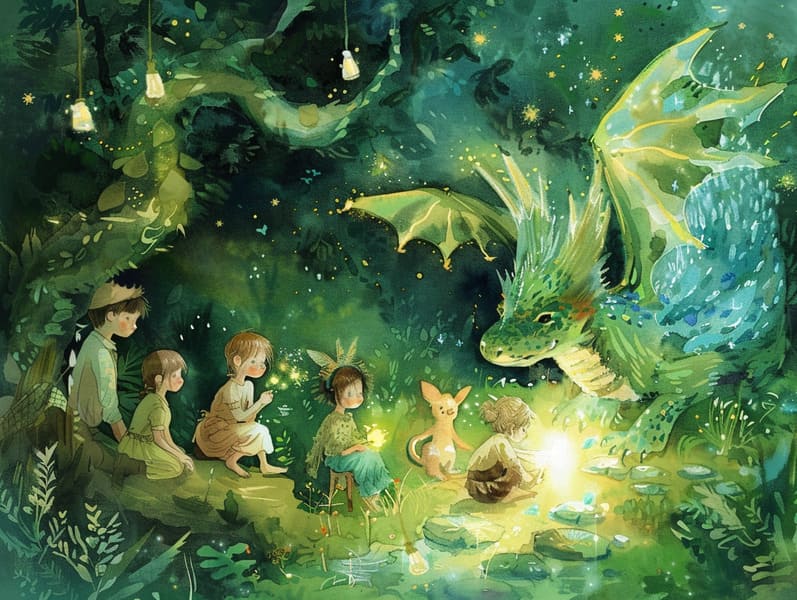Delving into the Background of Classic Fairy Tales with the Lasting Grace.

Vintage fairy tales have legendary status. These stories have been told from one generation to the next far before they were ever transcribed. They were born from a variety of backgrounds, including European traditions. They were initially conveyed among mature audiences, often carrying themes and messages mirroring the societal norms and beliefs of the time.
The Grimm brothers, Jacob and Wilhelm (the Grimm brothers), were among the first to collect many of these beloved fairy tales. Their published works, "Grimm's Folk Tales," included classics like "The Little Glass Slipper," "The Story of Hansel and Gretel," and "Schneewittchen," which have since become staples in the world of famous fairy tales. Similarly, the Danish author's enchanting stories, such as "The Little Mermaid," and "The Duckling that Could," have floated into hearts worldwide, securing their place in the pantheon of famous fairy tales.
Despite their age, traditional fairy tales remain as significant as ever, especially as nighttime stories for kids. These whimsical stories are now available in different formats, including richly illustrated books, whimsical animations, and internet fairy tales.
Their continued relevance can be ascribed to several fascinating points:
Moral Lessons: Traditional fairy tales often provide important moral lessons. Tales like "The Boy Who Cried Wolf" teach the benefit of integrity, while "The Tortoise and the Hare" highlight the values of determination and unpretentiousness. These stories offer children clear distinctions between ethical and unethical, molding their moral compass in a subtle yet significant way.
Empathy and Awareness: Traditional fairy tales frequently present characters facing difficulties and adversities, encouraging readers to empathize with their struggles and support their triumphs. For instance, "The Tale of Beauty and the Beast" demonstrates the merit of looking deeper to acknowledge the real person of a individual, promoting tenderness and appreciation.
Cultural Understanding: Many timeless fairy tales are rooted in the cultural contexts from which they came. Learning from these fairy tales can provide delightful insights into different beliefs, developing a sense of world appreciation and perception.
Fantasy and Innovation: The fantastical elements in traditional fairy tales—magical spells—revitalize children’s inventiveness. These tales carry readers to enchanted realms, boosting fantasy ideas and a sense of fascination that stays a lifetime.
Traditional fairy tales are not only magical but also illuminating. They act as fantastical tools in enhancing various thinking and feeling skills in the young. When old fairy tales are told out loud, they develop verbal skills by presenting new terms and elaborate sentence structures. This practice also improves listening abilities and mental focus, as young readers keep up with the story, excited to see what happens next.
Furthermore, contemplating the themes and characters of ancient fairy tales can advance thinking skills and intellectual skills. The young are taught to discover patterns, foresee events, and comprehend cause and effect. These contemplations also ease the young express their thoughts and feelings, fostering their emotional intelligence.
In today’s information age, the availability of online fairy tales has made these tales more within reach than ever. Internet resources and software offer vast collections of children's fairy tales that can be experienced or listened via anytime, anywhere. Fairy tales recited are particularly common, supplying an fun way for young readers to be a part of these bewitching tales. Read-aloud stories and narrated videos transport characters and settings to life, often supplemented by charming sound effects and tunes that intensify the narrative experience.
The lasting allure of traditional fairy tales lies in their ability to evolve to current eras while keeping hold of their main lessons. Contemporary revisions of these tales often incorporate more representative figures and modern settings, making them understandable to today’s audience. However, the essential messages of valour, warmth, and honesty remain unchanged, continuing to impact audiences of all ages.
Classic fairy tales also offer a sense of comfort and closeness. They render accessible a methodical narrative with a definite beginning, middle, and end, often coming to a close with the culmination of conflicts and the triumph of right over wrong. This predictability can be encouraging for kids, imparting a sense of firmness in an unstable world.
Classic fairy tales continue get more info to enchant and train new generations, maintaining their grandeur and meaningfulness in modern society. As children's night stories, they deliver up a perfect blend of delight and instruction, backing moral values, empathy, and creativity. The proliferation of internet fairy tales and the likability of fairy tales read aloud certify that these classic narratives remain acquirable to new generations.
By preserving and sharing these stories, we continue to treasure the rich tapestry of tradition and cultural heritage. Whether you are accessing a gorgeously illustrated book, exploring a virtual collection, or listening to an voice book, the grace of classic fairy tales is always within reach. These tales demonstrate of the unceasing spell of fairy tales and its ability to bind us across epochs and places.
Even if you are accessing a beautifully illustrated book, experiencing a electronic library, or hearing an narrated book, the mystique of bedtime fairy tales is always within reach.
These fairy tales reveal of the undying effect of tales and its ability to hold us together across generations and cultures, weaving a spell that charms and informs alike.